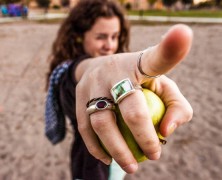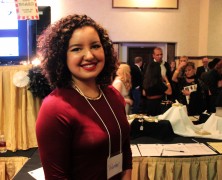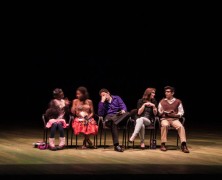SFUAD Film major Sara Esparsa talks about the differences between Victoria, Spain and Santa Fe, New Mexico, along with some of her favorite aspects of Santa Fe. In the end she says, “Santa Fe is a great opportunity to be yourself and to create...
Q/A W Cristina Kahlo
posted by Arianna Sullivan
Cristina Kahlo, great-granddaughter of Guillermo Kahlo and great-niece of Frida Kahlo, is a practicing photographer and member of Maestro Julio Galindo’s Platinum Print Workshop in Mexico City. She visited Santa Fe this October to attend the Alternative Photographic International Symposium sponsored by Bostick and Sullivan, Inc. and chatted with The Jackalope Magazine about her relationship to photography. Kahlo’s photographs will be on exhibit at the Santa Fe University of Art and Design’s Marion Center Gallery with four other photographers until Nov. 8. The following interview has been edited for brevity. Jackalope Magazine: When did you discover photography? Cristina Kahlo: My father was an amateur photographer—he was always playing with cameras. The darkroom was a place for adults. Children were not allowed. There was a special lock on the door so that children could not get in. So when I was 10 or 11 years old and my father invited me in, it was like I was being allowed into a forbidden room. He enlarged a picture of a family picnic and showed me how to submerge the photo paper in the chemicals, and that moment of seeing the image appear on the paper was magic. That is when I discovered what it means to make a photograph, and the moment when I fell in love with photography. JM: How did you pursue that newfound love? CK: My father died young. He was 42, and I was 13. But after he died, his darkroom was still in the house. A brother of a friend of mine did photography, and he said, ‘you like photography, don’t you,’ and he showed me the ABCs. That’s how I started printing. Then when I was 16 years old, I started at the Escuela Activa de Photographia, the only school...
Be Bold
posted by Arianna Sullivan
LA Times book critic David Ulin is loathe to give advice. Or so he said, during a Q&A during his visit to the Santa Fe University of Art and Design last week. However, the entirety of Ulin’s visit to SFUAD was an inadvertent how-to course for writers. First and foremost, says Ulin, “Writing is a practice, not a religion!” Ulin learned this by pursuing a job that challenges his writing skills daily. Ulin’s job and his personal writing are a part of the same world: Writing criticism is a “writerly practice,” and he works each day to craft reviews that are “also satisfying reading experiences.” That said, writing on a deadline, another aspect of Ulin’s job, “removes the preciousness” from the work. With a new story due every day, it is imperative for a writer to be able to crank words out and let them go as soon as the final draft goes to the editor. This is coming from a man who worked on a novel for nearly thirty years before he scrapped it, though he could have worked on it until he was eighty. “It’s important to remember that all writers are a part of a conversation,” says Ulin, “and if nobody ever sees your work, you’re not really taking part.” Which leads to another recommendation: Get your work out there. Ulin is a private writer. He never reads works in progress at public readings. Yet that is exactly what he did in O’Shaughnessy last week. “I keep sharing this piece at readings,” he said, “as if to light a fire under my ass to finish it.” Having a fire under the ass is important for getting work done, and one way to help keep it lit is to say “yes” to...
Helping Hand
posted by Maria Costasnovo
Big Brothers Big Sisters of Northern New Mexico recently held its annual gala, a fundraising event for the organization, this year held at Buffalo Thunder Hotel, drawing volunteers from all over northern New Mexico—including Santa Fe University of Art and Design. “Preparing an event like this is always hard, but fun at the same time. It is really important for Big Brothers Big Sisters since it’s one of the sources from we get most of the funds of the year for the kids,” says Chris Leslie, one of the organizers of the event. A lot of different business and people from all over northern New Mexico donated items ranging from furniture and jewelry to hotel rooms and trips. SFUAD student Dani Vondrak, a regular volunteer for BBBS, helped gather volunteers for the event. “On the event day we showed up and ask some of the people who were in charge what we could do to help out, and a lot of them were telling us that we should be behind the booths of the art pieces or vacations that are bet on, to kind of exemplify what they were about and explain why they should bet on that,” says SFUAD student Victoria Ann Dailey. This event also was an opportunity for some of the students to put their skills to use. Charles Austin Ross, a film student, helped in the gala with his camera: “I got this project by a stroke of luck. I was talking to Ron Nunnely over at the [Driscoll Fitness Center] and a friend and member of the gym came in to talk to him. Chris Alexander of Big Brothers Big Sisters was that friend, a really nice guy. He asked my major and I told him Film and so he extended an offer my way.” After the auction,...
Middletown Delivers
posted by Nick Martinez
Middletown, the latest SFUAD Performing Arts Department production, opens with Curtis Williams’ Public Speaker waxing philosophic about the nature of small towns. It’s a fun digression that captures the high energy and inherent sadness of the mostly plot-less but emotionally poignant show that follows. The play has an ensemble cast, but there are a few characters given the most time to shine, including: Mathew Eldridge’s John Dodge; Porscha Shaw’s Mary Swanson; Michael Phillip Thomas’s Cop; and Jade Lewis’s Mechanic. Eldridge and Shaw did a phenomenal job carrying the emotional weight for much of the play. Due to the structure of the play, many of the actors had the difficult job of taking what could easily be one-note characters and adding pathos. It seems lazy to make such a blanket statement, but the whole cast was really up to the challenge. Not every joke landed, and not every character left the same impression, but the batting average is so high, it is easy to brush off the shortcomings. Maia Rychlik’s Librarian and Yusef Seevers’s Doctor, in particular, breathed such life into simple characters that leave one combing through all of their dialogue for hidden meaning long after you leave Greer Garson Theatre. The two scenes that stood out most were the scene in space and Lewis’s scene with Tallis Geohegan-Freifeld’s Doctor. The scene in space, featuring Matt McMillan and Robert Henkel Jr. is nestled towards the end of Act One. The scene is by far the most removed from the plot, but is the first point where the themes are front and center. McMillan and Henkel Jr.’s subtle performance prevents the message from being overbearing. Chelsea Kuehnel’s sets are also a delight in their simplicity, giving the space scene a magical feel and the dusty...






 Jackalope Magazine is the student magazine of Santa Fe University of Art and Design. Building on the interdisciplinary nature of our education, we aim to showcase the talent of our university and character of our city.
Jackalope Magazine is the student magazine of Santa Fe University of Art and Design. Building on the interdisciplinary nature of our education, we aim to showcase the talent of our university and character of our city.
Recent Comments